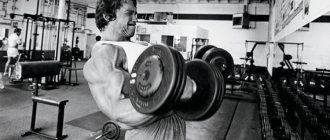About load progression
The rate of muscle growth depends on the load - that's a fact. However, it is a mistake to believe that for hypertrophy you need to constantly work at the limit of your capabilities. Indeed, increasing working weight is very important, but this should not be taken too literally.
For clarity, consider the following example. A beginner comes to the gym with the goal of becoming a bodybuilder and in the future taking prizes in competitions. The goal is good and achievable, but you need to approach the issue of implementing your plan wisely.
This person has studied the theory well and knows where to start. For the first two months he follows the basic program. The body gradually becomes toned, the muscles develop, and perhaps during this period there will be a slight increase in muscle mass (2-4 kg). Over time, the athlete changes the training program; in addition to the basics, he performs isolated exercises for different muscle groups. A person knows that muscles grow under heavy workload, so each training session increases the working weights. At first it really gives a good result, but at some point progress slows down or stops altogether. The athlete does not give up and adds more weight, even if it is ahead of his own training plan. The muscles are constantly stressed, the person feels overwhelmed, and the result is still far from the desired one. What do most amateurs do in this case? Either they increase the weight even more, or use sports pharmacology. The result depends on how persistently a person continues to exercise, but most often this ends in the development of overtraining syndrome.
Unfortunately, this is a real example. In every gym, at least 30% of those training without a trainer sooner or later come to this result, and all because the person did not understand such an issue as periodization of loads in bodybuilding.
Light weights cause fewer injuries than heavy ones
"Working with light weights allows you to perform movements correctly and accurately," Ashley Verma, founder of Define.London, told INSIDER. “Plus, the risk of injury is much lower.”
In fact, lifting light weights is not as easy as it might seem. Even those who consider themselves kings of the gym have difficulty lifting 1.5 kg dumbbells for five seconds.
The 1920s mansion even has an award-winning private cinema (photos)
Areplivir, approved by the Ministry of Health, destroys the COVID-19 virus in 5-6 days
To the 50th anniversary of the cartoon: in “Well, wait a minute!” roe deer, badger and hedgehog will appear
What is load periodization?
The term “periodization” appeared in bodybuilding quite recently. Until this time, the only correct solution was stable, intense training at maximum capacity. The exercises changed, but the load remained consistently high with a gradual increase. However, recent studies have proven that there is no point in fully loading your muscles every workout. This is how periodization of loads appeared, the meaning of which is to alternate light and heavy training.
This process involves cycling training direction, intensity and volume to achieve better results with less risk of mental and physical exhaustion. If you simplify the scheme as much as possible, you get an alternation of hard and light workouts. At the same time, there is less fatigue, more energy, and progress in gaining muscle mass is more stable.
The meaning of light training in bodybuilding
A light workout allows you to maintain tone without clogging your muscles. It is considered as an intermediate stage between full-fledged exercises, to which the muscles are already accustomed.
Advantages of this approach:
- reducing the risk of getting overtraining syndrome;
- increased amount of energy;
- achieving better results on hard training days;
- complete muscle rest.
The body recovers after intense exercise on average within 60-72 hours. It is clear that a bodybuilder does not load all muscle groups in one workout, so athletes can fully train 3-4 times a week. Introducing light workouts into your workout plan will help you recover even better, without compromising your further progress.
Periodization rules
The issue of periodization is discussed in detail in numerous books on bodybuilding. There are many different systems - dividing the training process into microcycles, macrocycles and mesocycles.
Macrocyclic periodization is a detailed lesson plan for the whole year ahead. Moreover, each macrocycle consists of several mesocycles, which are divided into microcycles. In fact, each mesocycle is designed for 3-4 months, during which the athlete first focuses on building muscle mass, then on working out lagging groups, and then on “drying” the body. This construction is called linear cycling, since the cycles follow one after another, and in each the goals are lined up sequentially. Each mesocycle pursues one goal - muscle hypertrophy, development of strength and endurance, or drying. The disadvantage of this approach is that the transition to a new cycle leads to a partial loss of progress from the previous stage.
Nonlinear cycling is the very introduction of light training. This approach consists of non-linear microcycles in which days of intense training are followed by lighter loads.
Calorie surplus
This doesn't mean that lifting weights will make you look like a bodybuilder. You will only build muscle if you are in a calorie surplus—that is, you need to consume more energy than you burn.
If your goal is simply to improve your body composition, Worthington recommends doing three to four sets of eight to 12 reps.
Unlike Rain and Verma, Worthington doesn't advocate training with very light weights. "There's really no benefit to it, even in the early stages of injury rehabilitation," he says.
Aesthetic changes are, by and large, about reducing body fat relative to muscle tissue, so you should aim to induce a hypertrophy response when manipulating calories (a surplus to gain muscle mass; a deficit to lose fat). For this hypertrophy response, you need to lift fairly heavy weights.
Can you choose a movie yet? A possible date for the opening of cinemas in Russia has been announced
How to fold towels: rolled or folded? People's opinions are divided
Game of Thrones continues. Martin will soon release a sequel to The Winds of Winter
Easy workouts
Light training is based on one of the following principles:
- less weight - more repetitions;
- less weight – standard number of approaches and repetitions;
- medium weight – low reps.
The first option is suitable for inexperienced athletes who cannot yet work with really heavy weights, but have already encountered a deterioration in their progress. Typically, this problem is faced by people with an asthenic physique who build muscle mass very slowly. In this case, if the maximum working weight is 50 kg for a certain exercise, 25 kg should be used as a weak load, but the number of approaches and repetitions should be increased. So, if during an intensive session 3 approaches are performed 8 times, and this is the maximum that an athlete is capable of at this level of training, then on a day of light training 4-5 approaches are performed, but 12-15 times.
The second principle is used most often. This scheme is used by athletes who have already achieved certain success and work with quite a lot of weight. In this case, you need to repeat your usual workout, just taking a weight of 50-60% of your usual. At the same time, it is important to strictly follow your standard plan, down to the duration of rest between approaches and different exercises.
The third principle is used primarily in powerlifting. This approach is aimed at increasing strength and endurance. In this case, a weight equal to 70% of the working weight is used, the rest does not change in the training plan.
Lifting weights will help you increase strength
However, if you want to build bulging muscles, you need to lift heavy weights. If you choose heavy weights, you won't be able to do very many repetitions at a time.
Make your meetings with loved ones regular: 3 steps to mental health
No need to complicate things: burpees and a jump rope are all you need for perfect fitness
Second life of food: don’t rush to throw away banana skins and stale bread
"Higher loads and lower repetitions equal greater strength gains," explained Worthington, a former international athlete whose celebrity roster includes world champions in a number of disciplines. For example, among his clients is fashion model Winnie Harlow.
How to enter into a weekly plan?
The rules for introducing such classes depend on what program the athlete is engaged in.
- Circuit training is widely used to increase endurance and strength. The bottom line is that throughout the week the athlete performs the same exercises, usually working only one muscle group. In this case, on Monday there is heavy training with maximum weight, on Wednesday light training, and on Friday the plan of the first day is completely repeated.
- The standard training plan involves loading different muscle groups on different days. For example, on Monday the legs are worked out, on Wednesday – the back, on Friday – the chest and arms. In such cases, the plan is modified as follows: Monday - hard, Wednesday - easy, Friday - hard, Monday - easy, etc. The plan is designed for two weeks, as a result, over 14 days, each group being worked on trains intensively once, and lightly the second time.
- Another scheme is alternating heavy, medium and light loads. It can be fit into absolutely any training plan.
In general, there is no universal method for periodizing loads. There are a lot of them, and many athletes develop their own scheme, thanks to which they manage to exercise comfortably, but at the same time maintain constant progress.
How to do push-ups correctly?
Parallel bars are an excellent exercise machine for the chest, arms and shoulders. And performing a dip program engages your abs, back, and legs.
. True, the level of load depends on the technique of performing the exercises.
When starting to master the horizontal bar and parallel bars exercise machines, it is important to keep your balance and not “dangle”
.
Otherwise, you risk getting sprains and injuries. Standing along the bars, push off the ground with your feet, then grab the bars with your straight arms. Stay straight. Jump off smoothly. You need to reach the uneven bars using your arms and shoulders
.
It is important to do push-ups correctly
. Bend your knees (to a right angle), then cross them (as shown in the photo above). This will add stability. Bend slightly forward, and as you exhale, bend your elbows to a right angle. Do not spread your arms to the sides; your elbows should be pressed as close to your body as possible.
As you exhale, straighten up. If you feel warmth in your triceps, you're doing everything right.
.
To work the pectoral muscles, go lower. But the angle at the elbow should be about 30 degrees. At first, it is better to refuse such a complication. And when the body finds it easy to do the initial version of the exercise, move on to the more complicated version.
The break between approaches should be up to 2 minutes.
Who else needs a light workout?
In addition to periodization of loads, light training can and should be used when it is necessary to recover from injuries or to enter the training process after a long break. In the first case, the load is selected individually, depending on how much time has passed since the injury. In the second case, you should start with a light load, increase it by at least 30% for the next session, and observe your own well-being. Based on your own feelings, build a further lesson plan.
Light training is very important in bodybuilding. With the right approach, they will not reduce strength and endurance, but, on the contrary, will accelerate progress and stimulate further muscle hypertrophy.









